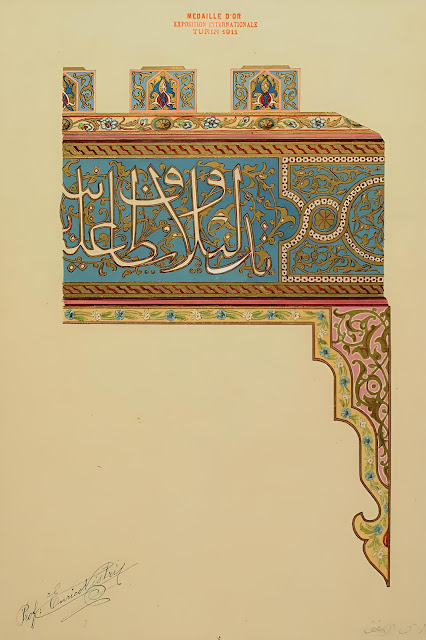Enrico Nistri
Enrico Nistri was born at Pisa in
1871, and, having received a general education, he entered upon a three
years' course of study at the Accademia di Belle Arti in Florence.
He spent two years at Lucca, and a further year at Florence, and in
1890 he gained a diploma for designs and painting. He taught drawing at the Reale Scuola Tecnica and became a professor
in the Government Schools at Spezia, where he remained for ten years,
during which time he qualified as a professor of calligraphy.
In 1891 Professor
Enrico Nistri, contractor, painter, and decorator, came to Cairo to join one of the leading local photographers
as artist and colorist (or aquarellist). Six months later he acquired an
interest in a firm of painting and decorating contractors, but in 1906
he decided to start business on his own account. The two brothers Giuseppe
and Enrico created two independent companies, possibly because of the heavy workload. Enrico Nistri, had found ample
scope for his talents in Egypt. Among his principal works were the
decoration of the Credit Foncier Egyptien, the Palace Suares, the Villa
Beyerly, the Scuola Duretto, the Government Polytechnical School and the
engagement on extensive schemes of decorative work for the Heliopolis
Oasis Company, and for the Egyptian Government. The Company obtained great success, and received commissions from the royal
family, other government institutions, and private individuals.
In Cairo, Nistri was quite successful, winning several prestigious orders. At its peak, his company employed a staff of about 200 people. Between 1906 and 1910, the company worked for public and private clients, collaborating with well-known construction companies and with international architects who operated in Cairo. Nistri offered decorations inspired by the traditional motifs of Islamic art, alongside a repertory which drew on figurative and typographical motifs from Europe. The gold medal won in 1911 at the International Exposition of Turin for the drawings reproducing interior ornaments of mosques, villas, and palaces was public recognition of the company’s contribution. Nistri directed it until 1919, when his grandson Gino Cattani and son-in-law Bardelli took over. In 1932, Bardelli was formally appointed Chief Executive Officer. Nistri died in 1922 in Viareggio, where a decade earlier he had built his residence, a small villa which was decorated inside and out with Oriental motifs, some of which had been inspired by the best ornaments of Cairo’s mosques.
Nistri's showroom, Cairo, Egypt (1906-1910). Enrico Nistri's private archive.
Facade of Enrico Nistri’s warehouse, Cairo. Enrico Nistri private archives.
Mosque decoration proposal by Enrico Nistri (Stamp: Gold medal at 1911 Turin Exhibition): Detail of the painted wood ceiling and ceiling frieze, frieze on the wooden ceiling beams, dome and stalactites. Enrico Nistri private archives.
Album
Cover of the Nistri's company, Cairo, (1906-1910). Enrico Nistri is an
entrepreneur of paintings and artistic decorations in Cairo, Egypt.
Enrico Nistri's private archive.
Credit: Annuario degli italiani d’Egitto, Alexandria, 1933, p. 196; Annuario degli italiani d’Egitto, Cairo, 1939, p. n.n.; Annuario generale, op.cit., p. 232; A. Belluomini Pucci, “Presenze, immagini, caratteri dell’Oriente a Viareggio nel Novecento,” in “Presenze straniere e minoranze religiose a Viareggio, figure, documenti, testimonianze,” Quaderni di storia e cultura viareggina, n. 2, 2001, p. 167-185.


.%20Enrico%20Nistri's%20private%20archive.2.jpg)











